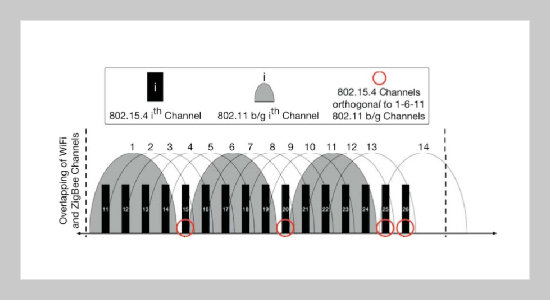REFERENCES
- [1] IEEE Standard 802.15.4e (2012) Part 15.4: Low-rate Wireless Personal Area Networks (LRWPANs) Amendament 1: MAC Sublayer, IEEE Std. 802.15.4e-2012, IEEE Comput. Soc. doi: 10.1109/IEEESTD.2012. 6185525
- [2] Tytgat, L., O. Yaron, S. Pollin, I. Moerman, and P. Demeester (2015) Analysis and Experimental Verification of Frequency-based Interference Avoidance Mechanisms in IEEE 802.15.4, IEEE/ACM Transactions on Networking 23(2), 369�382. doi: 10.1109/TNET. 2014.2300114
- [3] Hithnawi, A., H. Shafagh, and S. Duquennoy (2014) Understanding the Impact of Cross Technology Interference on IEEE 802.15.4, Proceedings of the 9th ACM International Workshop on Wireless Network Testbeds, Experimental Evaluation and Characterization, Maui, Hawaii, USA, 49�56. doi: 10.1145/2643230.2643235
- [4] Watteyne, T., A. Mehta, and A. Pister (2009) Reliability through Frequency Diversity: Why Channel Hopping Makes Sense,” Proceedings of the 6th ACM Symposium on Performance Evaluation of Wireless ad hoc, Sensor, and Ubiquitous Networks, Tenerife, Canary Islands, Spain, 116�123. doi: 10. 1145/1641876.1641898
- [5] Kotsiou, V., G. Z. Papadopoulos, P. Chatzimisios, and F. Theoleyre (2017) Is Local Blacklisting Relevant in Slow Channel Hopping Low-power Wireless Networks? IEEE International Conference on Communications. doi: 10.1109/ICC.2017.7996980
- [6] Song, L., S. Han, A. K. Mok, D. Chen, M. Lucas, and M. Nixon (2008) WirelessHART: Applying Wireless Technology in Real-time Industrial Process Control, IEEE Real-time and Embedded Technology and Applications Symposium. doi: 10.1109/RTAS.2008.15
- [7] Guglielmo, D. D., B. A. Nahas, S. Duquennoy, T. Voigt, and G. Anastasi (2017) Analysis and Experimental Evaluation of IEEE 802.15.4e TSCH CSMA-CA Algorithm, IEEE Transactions on Vehicular Technology 66(2), 1573�1588. doi: 10.1109/TVT.2016.2553176
- [8] ISA-100.11a-2011 (2011) Wireless Systems for Industrial Automation: Process Control and Related Applications, International Society of Automation (ISA), Std. 1.
- [9] WirelessHART Specification (2008) TDMA Data-link Layer, HART Communication Foundation Std., Rev 1.
- [10] Tang, L., Y. Sun, O. Gurewitz, and D. B. Johnson (2011) EM-MAC: a Dynamic Multichannel Energyefficient MAC Protocol for Wireless Sensor Networks, ACM MobiHoc. doi: 10.1145/2107502.2107533
- [11] Hanninen, M., J. Suhonen, T. D. Hamalainen, and M. Hannikainen (2011) Link Quality-based Channel Selection for Resource Constrained WSNs, Springer GPC. doi: 10.1007/978-3-642-20754-9_26
- [12] Tang, L., K. C. Wang, Y. Huang, and F. Gu (2007) Channel Characterization and Link Quality Assessment of IEEE 802.15.4-Compliant Radio for Factory Environments, IEEE Transactions on Industrial Informatics 3(2), 99�110. doi: 10.1109/TII.2007.898414
- [13] Pavkovic, B., F. Theoleyre, D. Barthel, and A. Duda (2010) Experimental Analysis and Characterization of a Wireless Sensor Network Environment, Proceedings of the 7th ACM Workshop on Performance Evaluation of Wireless Ad Hoc, Sensor, and Ubiquitous Networks, Bodrum, Turkey, 25�32. doi: 10.1145/1868589. 1868595
- [14] Gunatilaka, D., M. Sha, and C. Lu (2017) Impacts of Channel Selection on Industrial Wireless Sensor-actuator Networks, IEEE INFOCOM. doi: 10.1109/ INFOCOM.2017.8057049
- [15] Chiti, F., R. Fantacci, and A. Tani (2017) Performance Evaluation of an Adaptive Channel Allocation Technique for Cognitive Wireless Sensor Networks, IEEE Transactions on Vehicular Technology 66(6), 5351� 5363. doi: 10.1109/TVT.2016.2621140
- [16] Zacharias, S., T. Newe, S. O'Keeffe, and E. Lewis (2012) Coexistence Measurements and Analysis of IEEE 802.15.4 with Wi-Fi and Bluetooth for Vehicle Networks, IEEE International Conference on ITS Telecommunications, 785�790. doi: 10.1109/ITST.2012. 6425289
- [17] Du, P., and G. Roussos (2012) Adaptive Time Slotted Channel Hopping for Wireless Sensor Networks, IEEE CEEC. doi: 10.1109/CEEC.2012.6375374
- [18] Dujovne, D., L. Grieco, M. Palattella, and N. Accettura (2016) 6TiSCH 6top Scheduling Function Zero (SF0), Internet Engineering Task Force, (work in progress), 8.
- [19] Liu, Y., Y. He, M. Li, J. Wang, K. Liu, and X. Li (2013) Does Wireless Sensor Network Scale? AMeasurement Study on GreenOrbs, IEEE Transactions on Parallel and Distributed Systems 24(10), 1983�1993. doi: 10. 1109/TPDS.2012.216
- [20] Baccour, N., A. Koubaa, L. Mottola, et al. (2012) Radio Link Quality Estimation in Wireless Sensor Networks: a Survey, ACM Transactions on Sensor Networks 8(4), Article 34. doi: 10.1145/2240116.2240123
















